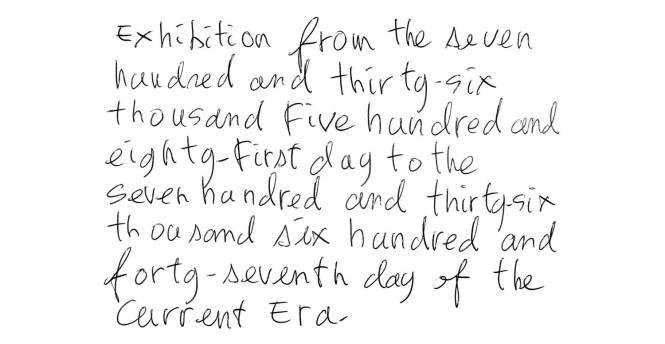Du 26/01/2018 au 28/04/2018

26.01.2018 until 05.05.2017
Exhibition with Jérémie Bennequin, Patrick Bernatchez, Julien Berthier, Nicolas Bourthoumieux, Marc Buchy, Claude Closky, Hanne Darboven, Alec De Busschère, Félicie d’Estienne d’Orves, David de Tscharner, Mark Geffriaud, On Kawara, Joseph Kosuth, LAb[au], Peter Lemmens, Albertine Meunier, Roman Opalka, Bertrand Planes, Sébastien Reuzé, Yann Sérandour, Seth Siegelaub, Hiroshi Sugimoto, Noémie Vulpian
*****
‘Le temps est le concept le plus difficile à définir dans notre vie, car il est notre vie elle-même. Chercher à l’illustrer ou y réfléchir est déjà, en soi, un paradoxe.’ Nam June Paik
Nous savons tous intuitivement ce qu’est le temps. Néanmoins des difficultés émergent très vite dès que nous y réfléchissons consciencieusement surtout si l’on ne né- glige pas de considérer à la fois le temps objectif et subjectif. En effet, contrairement à beaucoup d’autres notions, notre compréhension du temps dépend fortement d’une perception subjective basée sur un système de référence individuel, qui diffère d’une notion exacte et objective du temps.
Le temps est un concept élémentaire qui, alors que tout le monde pense savoir ce qui est en jeu, est très difficile à décrire précisément. Suivant ce constat, l’exposition présente des modèles artistiques qui remettent en question la notion de temps à travers des angles différents ou inhabituels, des modèles objectifs pour mesurer et calculer le temps à l’exploration empirique des phénomènes naturels, de l’examen à l’interrogation de l’Histoire, de la documentation sur l’expérience d’une vie personnelle au jeu construit sur une mythologie individuelle.
Après ‘xerox’ et ‘modus operandi’, cette exposition constitue le troisième volet d’un chapitre qui reflète l’héritage de l’art conceptuel dans l’art algorithmique. L’exposition se base alors sur la phénoménologie du temps de Edmund Husserl qui fait une distinction entre la mesure du temps (‘Zeitmessung’); la rationalisation, et la conscience du temps (‘Zeitbewustsein’); la subjectivation de notre Zeitgeist.
*****
Time is the most difficult term to define in our life, since it is our life itself. To show or to reflect upon is already a paradox.’ Nam June Paik
We all know what time is. Difficulties entangle however as soon as we consciously reflect on time and to bring into account both objective as subjective time. Unlike many other notions, our understanding of time depends of our subjective perception based on an individual reference system which is differing of an exact, objective time notion. Time is such an elementary concept that while everyone knows what is pointed at, it is hardly impossible to describe it precisely.
Accordingly, the exhibition presents artistic models which challenge the notion of time from both different as unusual angles, ranging from objective models to measure and calculate time, to empiric exploration of natural phenomena, over the examination and interrogation of history, to the documentation of personal life experience and the play of individual mythology.
After the exhibitions of ‘xerox’ and ‘modus operandi’ this show is the third of a chapter reflecting on the heritage of conceptual art in algorithmic art. As such the exhibition is based on Eduard Hussels phenomenology of time differentiating the measuring of time (what he calls ‘zeitmessung’); rationalisation, and the awareness of time (‘zeitbewustsein’), subjectivation of our Zeitgeist.
*****
Opening January 26, 2018 from 6 to 9 p.m
Exhibition on view from January 27 to May 5, 2018
Curated by : Société – Manuel Abendroth & Els I.R.L. Vermang